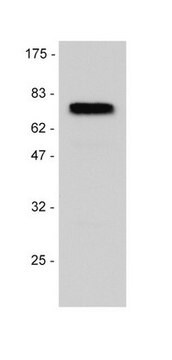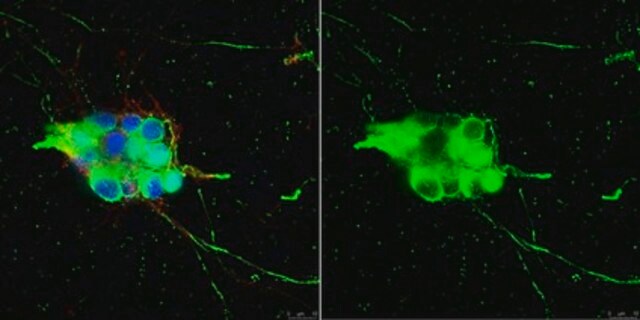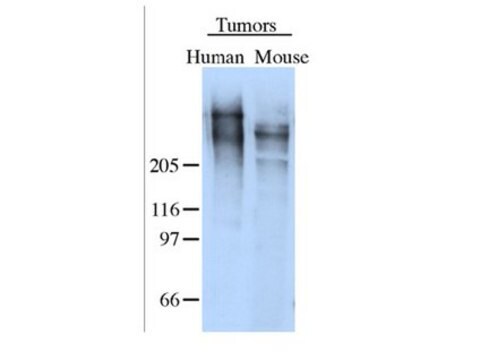ABN1655
Anti-p75NTR Antibody, ICD
serum, from rabbit
Synonyme(s) :
Tumor necrosis factor receptor superfamily member 16, CD271, Gp80-LNGFR, Low-affinity nerve growth factor receptor, Low affinity neurotrophin receptor p75NTR, NGF receptor, p75 ICD
About This Item
Produits recommandés
Source biologique
rabbit
Niveau de qualité
Forme d'anticorps
serum
Type de produit anticorps
primary antibodies
Clone
polyclonal
Espèces réactives
chicken, mouse, human, rat
Technique(s)
immunocytochemistry: suitable
immunofluorescence: suitable
immunoprecipitation (IP): suitable
western blot: suitable
Numéro d'accès NCBI
Numéro d'accès UniProt
Conditions d'expédition
ambient
Modification post-traductionnelle de la cible
unmodified
Informations sur le gène
rat ... Ngfr(24596)
Description générale
Spécificité
Immunogène
Application
Immunofluorescence Analysis: A representative lot localized p75ICD immunoreactivity in cryosections from various stages of chick embryos fixed with 4% paraformaldehyde and permeabilized by 0.1% Triton X-100 (López-Sánchez, N., et al. (2007). Physiol. Genomics. 30(2):156-171).
Immunoprecipitation Analysis: A representative lot co-immunoprecipitated NRIF with p75 from rat sympathetic neurons. Co-immunoprecipitation of exogenously expressed NRIF and p75 by this antiserum was also seen using 293 transfectant. Increased CTF and ICD fragments were immunoprecipitated from PMA-treated 293 transfectants and from BDNF-treated neurons (in the presence of proteasome inhibitor). Co-treatment with gamma-secretase inhibitor abolished ICD, but not CTF cleavage in PMA- and BDNF-treated cells (Kenchappa, R.S., et al. (2006). Neuron. 50(2):219-232).
Western Blotting Analysis: A representative lot detected p75 in rat sympathetic neurons. Increased ~30 kDa CTF and ~25 kDa ICD fragments were detected from BDNF- or PMA-, but not NGF-, treated neurons (in the presence of proteasome inhibitor). Co-treatment with gamma-secretase inhibitor abolished ICD, but not CTF cleavage in BDNF-treated cells (Kenchappa, R.S., et al. (2006). Neuron. 50(2):219-232).
Western Blotting Analysis: A representative lot detected p75 in superior cervical ganglia (SCG) whole tissue lysate from P4 and P24 postnatal rats. CTF and ICD fragments were detected only in P4, but not P24 SCG lysate (Kenchappa, R.S., et al. (2006). Neuron. 50(2):219-232).
Neuroscience
Qualité
Western Blotting Analysis: A 1:5,000 dilution of this antiserum detected the ~25 kDa p75NTR (neurotrophin receptor) ICD fragment in 10 µg of mouse retina tissue lysate.
Description de la cible
Forme physique
Stockage et stabilité
Handling Recommendations: Upon receipt and prior to removing the cap, centrifuge the vial and gently mix the solution. Aliquot into microcentrifuge tubes and store at -20°C. Avoid repeated freeze/thaw cycles, which may damage IgG and affect product performance.
Autres remarques
Clause de non-responsabilité
Vous ne trouvez pas le bon produit ?
Essayez notre Outil de sélection de produits.
Code de la classe de stockage
12 - Non Combustible Liquids
Classe de danger pour l'eau (WGK)
WGK 1
Certificats d'analyse (COA)
Recherchez un Certificats d'analyse (COA) en saisissant le numéro de lot du produit. Les numéros de lot figurent sur l'étiquette du produit après les mots "Lot" ou "Batch".
Déjà en possession de ce produit ?
Retrouvez la documentation relative aux produits que vous avez récemment achetés dans la Bibliothèque de documents.
Notre équipe de scientifiques dispose d'une expérience dans tous les secteurs de la recherche, notamment en sciences de la vie, science des matériaux, synthèse chimique, chromatographie, analyse et dans de nombreux autres domaines..
Contacter notre Service technique








